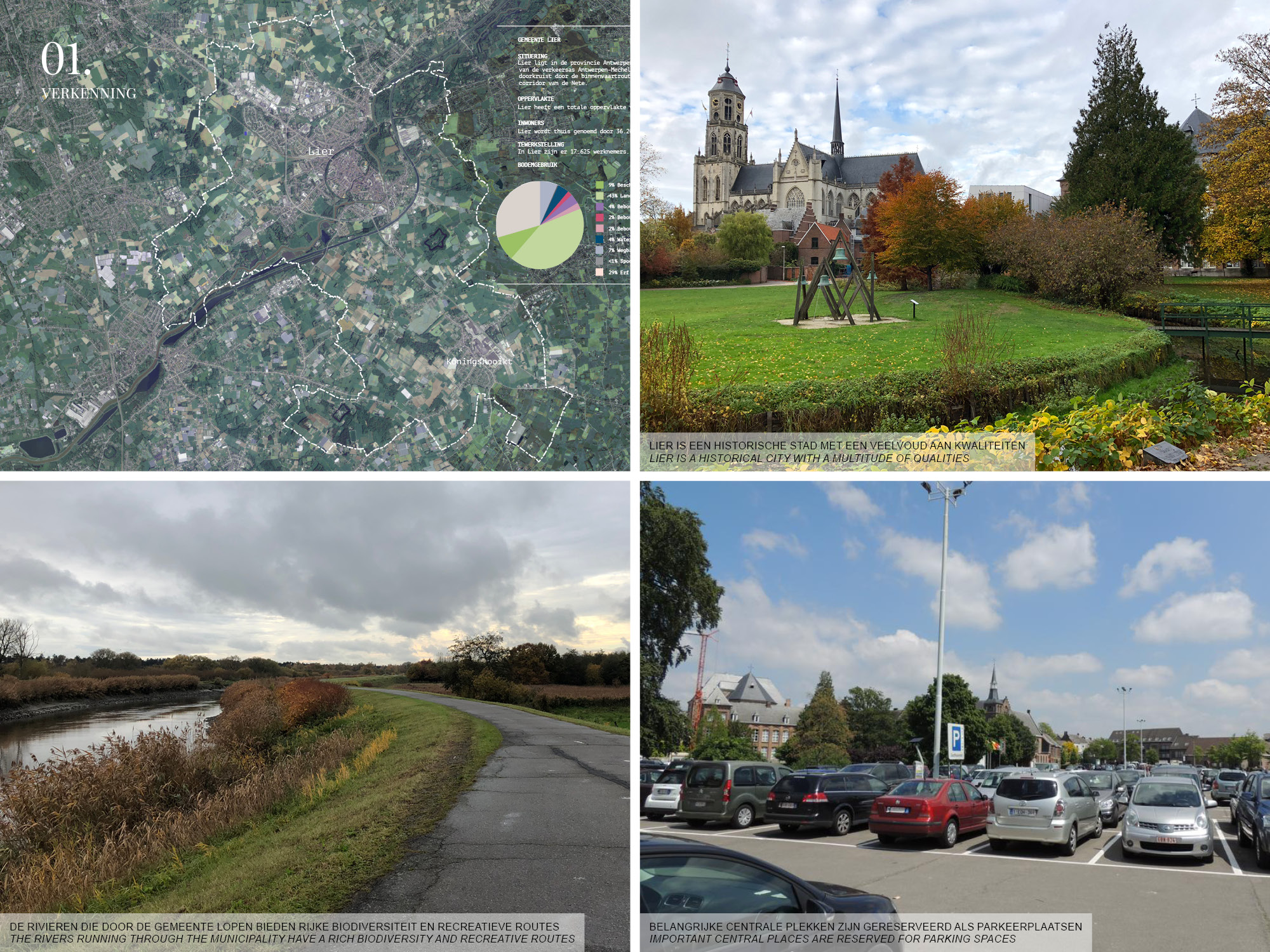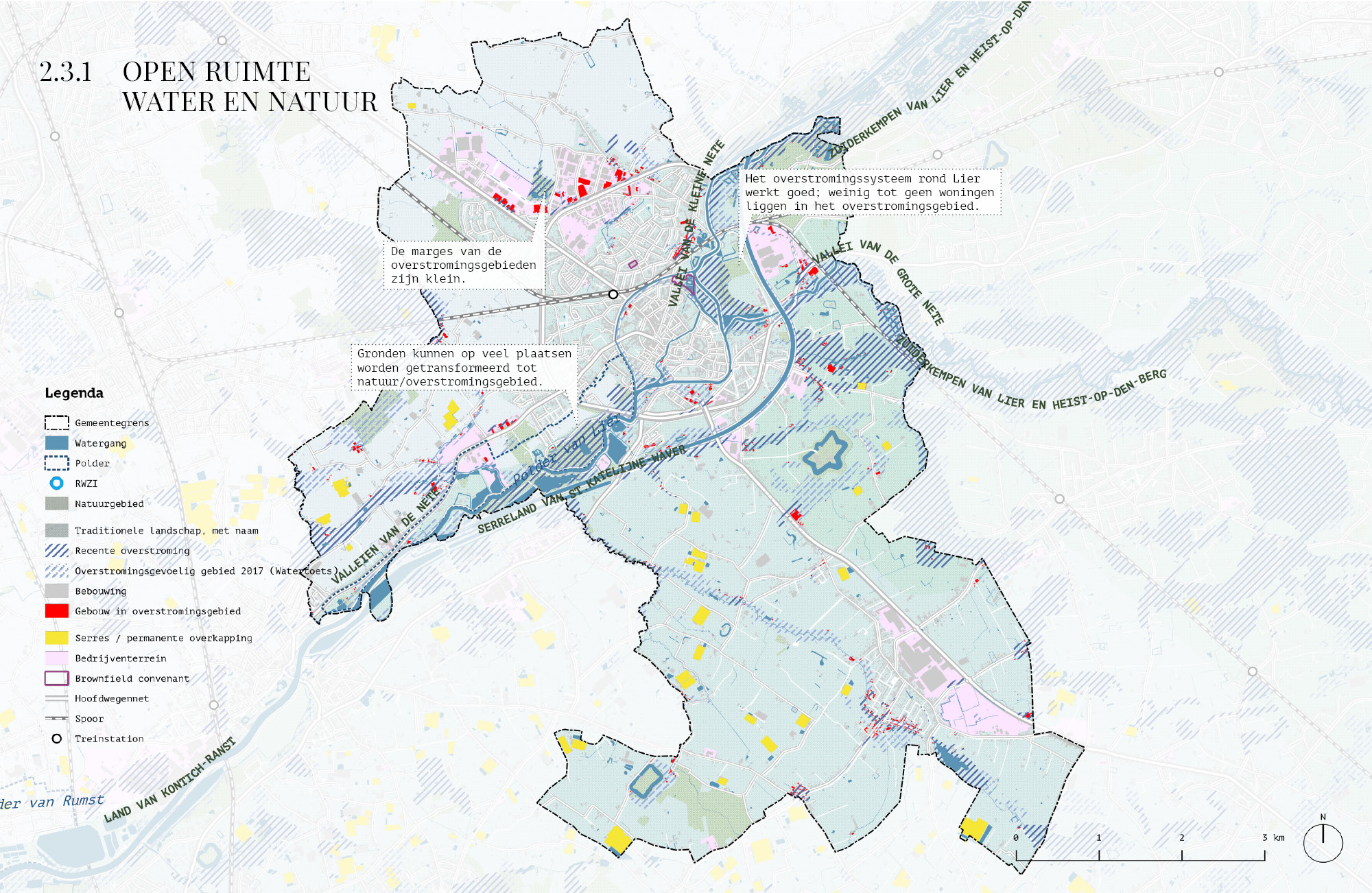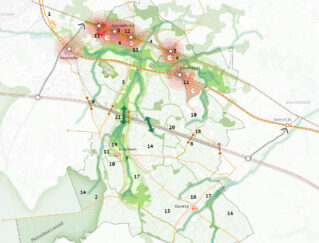Flanders’ is characterized by scattered spatial policy that has resulted in great loss of energy, biodiversity, time, money and space.
The ‘Bouwmeesterscan’ is a tool to help signal weaknesses and opportunities in spatial policy for local governments, and translates these into a concrete agenda of projects and policy changes for the transition towards a healthy and sustainable living environment. Spatial decisions are connected to challenges such as the energy transition, the mobility shift healthy urban environments and a balance between ecology and productive open space.
Lier is a city in the municipality of Antwerp with a compact historical center surrounded by green waterways that bring nature to the doorstep of Lier’s inhabitants. A second border of the built space is the ring road surrounding the city. This road forms a barrier for soft road users, and the connected radial roads and mobility hubs are of insufficient quality. To answer to the urbanization pressure in the municipality it is necessary to strengthen its green heart in service of its citizens, and link new developments to this access to green public space.
In the open space there are effective flooding policies in place, which offer great ecological value, but also a fragmented productive landscape, inhibiting for instance the energy transition. Also here is investigated how structural measures can help sustainable policy.
The full report can be found on the website of the Flemish Bouwmeester: vlaamsbouwmeester.be
Status: Study 2019
Team: Johan de Wachter, Joris van Arkel
Collaboration: PosadMaxwan
Client: Team Vlaamse Bouwmeester, Gemeente Lier
Location: Lier, BE










Flanders’ is characterized by scattered spatial policy that has resulted in great loss of energy, biodiversity, time, money and space.
The ‘Bouwmeesterscan’ is a tool to help signal weaknesses and opportunities in spatial policy for local governments, and translates these into a concrete agenda of projects and policy changes for the transition towards a healthy and sustainable living environment. Spatial decisions are connected to challenges such as the energy transition, the mobility shift healthy urban environments and a balance between ecology and productive open space.
Lier is a city in the municipality of Antwerp with a compact historical center surrounded by green waterways that bring nature to the doorstep of Lier’s inhabitants. A second border of the built space is the ring road surrounding the city. This road forms a barrier for soft road users, and the connected radial roads and mobility hubs are of insufficient quality. To answer to the urbanization pressure in the municipality it is necessary to strengthen its green heart in service of its citizens, and link new developments to this access to green public space.
In the open space there are effective flooding policies in place, which offer great ecological value, but also a fragmented productive landscape, inhibiting for instance the energy transition. Also here is investigated how structural measures can help sustainable policy.
The full report can be found on the website of the Flemish Bouwmeester: vlaamsbouwmeester.be
Status: Study 2019
Team: Johan de Wachter, Joris van Arkel
Collaboration: PosadMaxwan
Client: Team Vlaamse Bouwmeester, Gemeente Lier
Location: Lier, BE
Flanders’ is characterized by scattered spatial policy that has resulted in great loss of energy, biodiversity, time, money and space.
The ‘Bouwmeesterscan’ is a tool to help signal weaknesses and opportunities in spatial policy for local governments, and translates these into a concrete agenda of projects and policy changes for the transition towards a healthy and sustainable living environment. Spatial decisions are connected to challenges such as the energy transition, the mobility shift healthy urban environments and a balance between ecology and productive open space.
Lier is a city in the municipality of Antwerp with a compact historical center surrounded by green waterways that bring nature to the doorstep of Lier’s inhabitants. A second border of the built space is the ring road surrounding the city. This road forms a barrier for soft road users, and the connected radial roads and mobility hubs are of insufficient quality. To answer to the urbanization pressure in the municipality it is necessary to strengthen its green heart in service of its citizens, and link new developments to this access to green public space.
In the open space there are effective flooding policies in place, which offer great ecological value, but also a fragmented productive landscape, inhibiting for instance the energy transition. Also here is investigated how structural measures can help sustainable policy.
The full report can be found on the website of the Flemish Bouwmeester: vlaamsbouwmeester.be
Status: Study 2019
Team: Johan de Wachter, Joris van Arkel
Collaboration: PosadMaxwan
Client: Team Vlaamse Bouwmeester, Gemeente Lier
Location: Lier, BE




